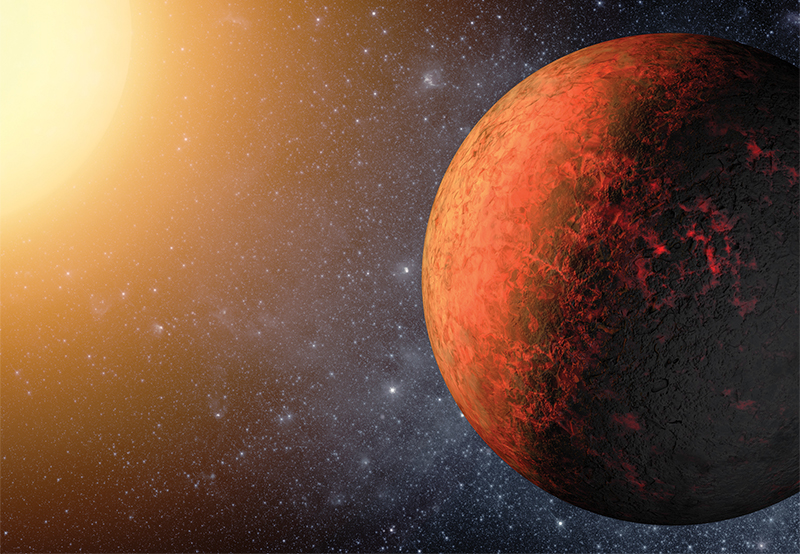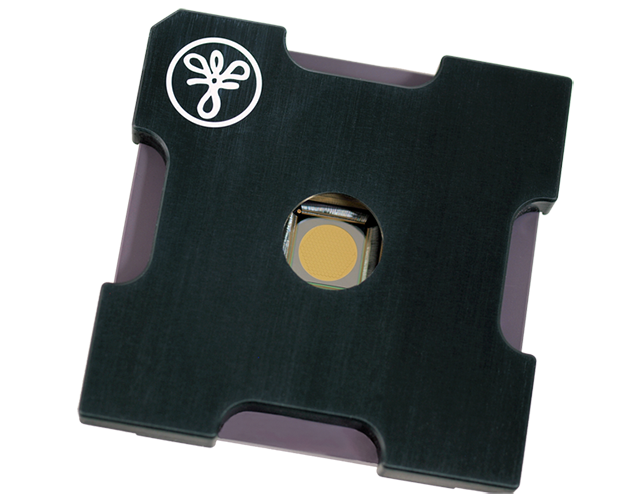
Deformable Mirrors Capture Exoplanet Data, Reflect Lasers
NASA Technology
We have always wondered: Is there other life out there? Are there other planets like our own, orbiting other stars like our Sun? In the early 1990s, astronomers began to discover that there are other planetary systems around other stars in our galaxy. Referred to as exoplanets (to distinguish them from planets in our own solar system), more evidence is being accumulated to reveal whether these systems do indeed resemble our own.
In 2009, the Kepler telescope launched to survey part of our galaxy in an effort to find Earth-size planets in or near zones around other stars where liquid water and life might exist. Because exoplanets are small and distant, and because the stars they orbit are so bright, it is difficult to observe exoplanets directly. Instead, Kepler uses sensitive instruments to measure light and looks for subtle dips in the brightness of a star caused by a planet crossing in front of it.
While Kepler has gazed at more than 156,000 stars in its field of view, NASA has planned new missions to image exoplanets around particularly bright stars. One such mission, the Balloon Exoplanet Nulling Interferometer (BENI), could be ready to fly in 2016 at 135,000 feet above Earth to image exoplanets in a matter of hours.
The BENI mission will require the use of a new instrument called a visible nulling coronagraph (VNC) to detect, image, and characterize exoplanets. Rick Lyon, a scientist at Goddard Space Flight Center, says, “Coronagraphs absorb, reflect, diffract, or interfere starlight to make the planet appear brighter than the star.”
An issue associated with the coronagraph, however, is that starlight can seep through and lower the contrast in an image. To address the problem, Goddard turned to deformable mirrors (DMs), which can adjust their shape or position to correct for the unwanted light.
Technology Transfer
In 2005, Berkeley, California-based Iris AO, Inc. started working with Goddard through the Small Business Innovation Research (SBIR) program to improve the company’s microelectromechanical (MEMS) DMs for the purposes of imaging and characterizing exoplanets. According to Lyon, “It is considered the most critical technology within the VNC.”
Michael Helmbrecht, president of Iris AO, says NASA wanted positioning accuracy down to the nanometer level and sub-nanometer resolution and stability—areas where little work had been done before. “It led us to design low-noise drive electronics that allow you to precisely position the mirror. We increased the precision and stability of the device significantly.”
Iris AO’s technology consists of hexagonal segments closely packed together to form the surface of the DM. This is much different from a traditional DM consisting of a single, continuous surface. “Each segment is articulated with 3 actuators to move up and down and tip and tilt, and each segment operates independently,” says Lyon.
For nearly a decade, Iris AO and Goddard have made great strides, and the improved DMs were tested and found to achieve “the best result of any nulling coronagraph to date,” says Lyon. Next up for Iris AO and Goddard is to increase the number of segments and actuators to get an even better optical correction.
Benefits
NASA is not the only organization interested in Iris AO’s successful technology. Unlike other manufacturers, Iris AO calibrates all of its DMs, which, according to Helmbrecht, “opens up a lot of applications where precise mirror positioning without feedback is required. Being able to precisely position the DM increases adaptive optics (AO) system performance as well.”
Outside of NASA, the technology is being both evaluated and used for biological research and industrial applications. In fact, the company has received funding from the National Eye Institute (NEI) and the National Science Foundation (NSF) to advance the technology for such applications.
The New England College of Optometry, the University of California, and Davis and Simon Frasier University in Canada are also using the spinoff technology in existing ophthalmic instruments to improve images of the eye. For retinal imaging, “It gives insights to researchers when they are studying diseases and helps to understand the processes of the eye and the human visual system. You can see the effects of diseases at fine details that would not be seen without AO technology,” says Helmbrecht.
In the near future, he finds, prescription drug manufacturers could use the technology to track the efficacy of drugs and see what is taking place in the back of the eyes of test animals during the course of treatment.
Along similar lines, the technology can be incorporated into biological microscopes to get a better view of tissues either on a slide or in vivo. “As you try to look deeper and deeper into the tissue, aberrations severely degrade imaging resolution and contrast. The deformable mirror technology can correct these aberrations and thus enable biologists to see further into tissue,” says Helmbrecht.
In an entirely different application, the technology also sees promise in shaping laser beams more precisely for manufacturing. Lasers are used in industrial laser micromachining to machine tiny electrical components for things like smart phones. Funding from NSF is enabling testing of the DMs to be able to handle large amounts of laser power.
“Increased power handling means higher throughput for laser micromachining systems,” says Helmbrecht. “In laser machining applications, the DM can be used to track focus, correct optical system aberrations, and to dynamically shape the beam intensity profile. Incorporating the DM greatly enhances the flexibility of laser micromachining systems to handle various materials and feature sizes. The industry needs techniques that are able to make very precise cuts into different materials.”
Whether it is helping to get a better look at exoplanets or the human eye, or to make laser beams more precise, Iris AO’s spinoff technology is sure to reveal things not seen before. Helmbrecht says it is only because of NASA and other government funding that the technology exists. “These kinds of partnerships have been absolutely invaluable for us. Without the commitment to cutting edge research, the technology would not be anywhere close to where it is today.”

The deformable mirror developed by Iris AO and improved through work with NASA is in use for applications ranging from NASA imaging systems for planet detection to state-of-the-art retinal imaging and microscopy.

This artist’s rendering shows Kepler-20e, the first planet smaller than the Earth discovered to orbit a star other than the sun. The planet always shows the same side to its host star, and could have large temperature differences between its permanent night and day sides.













